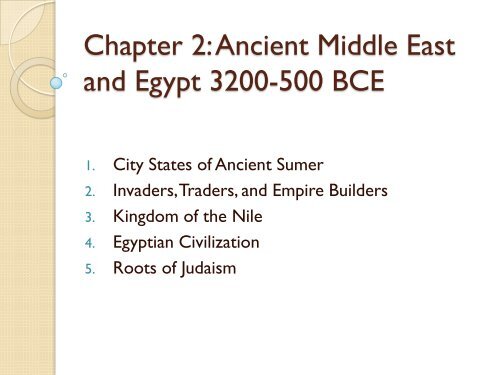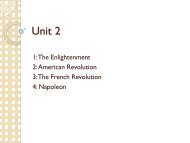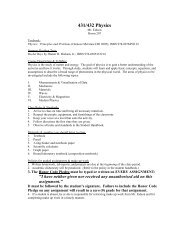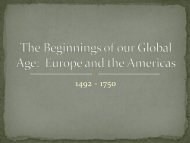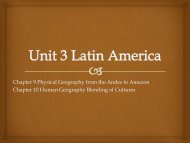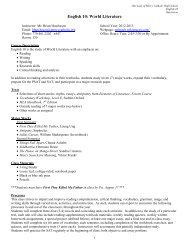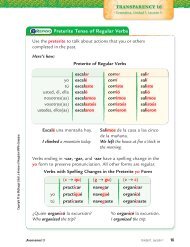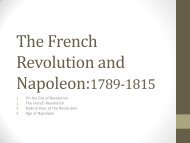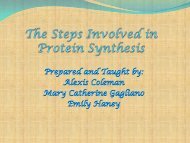Chapter 2: Ancient Middle East and Egypt 3200-500 BCE
Chapter 2: Ancient Middle East and Egypt 3200-500 BCE
Chapter 2: Ancient Middle East and Egypt 3200-500 BCE
Create successful ePaper yourself
Turn your PDF publications into a flip-book with our unique Google optimized e-Paper software.
<strong>Chapter</strong> 2: <strong>Ancient</strong> <strong>Middle</strong> <strong>East</strong><br />
<strong>and</strong> <strong>Egypt</strong> <strong>3200</strong>-<strong>500</strong> <strong>BCE</strong><br />
1. City States of <strong>Ancient</strong> Sumer<br />
2. Invaders, Traders, <strong>and</strong> Empire Builders<br />
3. Kingdom of the Nile<br />
4. <strong>Egypt</strong>ian Civilization<br />
5. Roots of Judaism
2.1City-States of <strong>Ancient</strong> Sumer:<br />
Underst<strong>and</strong> how geography influenced<br />
the development of civilization in the<br />
Fertile Crescent<br />
Outline the main features of Sumerian<br />
civilization<br />
Explain how the advances in learning<br />
made by the Sumerians left a lasting<br />
legacy for later peoples to build on
Terms, People, <strong>and</strong> Places<br />
Fertile Crescent<br />
Mesopotamia<br />
Sumer<br />
The Epic of Gilgamesh<br />
Hierarchy<br />
Ziggurat<br />
Cuneiform
Fertile Crescent<br />
Area in the middle<br />
east that is made up<br />
of rich soil<br />
Many have settled<br />
here due to few<br />
natural barriers<br />
Considered the<br />
“Cradle of<br />
Civilization”
Geography Influences the Fertile Crescent<br />
Starts in the Persian<br />
Gulf <strong>and</strong> goes to the<br />
Mediterranean Sea<br />
Mesopotamia: Means<br />
l<strong>and</strong> between rivers<br />
Area between Tigris<br />
<strong>and</strong> Euphrates rivers<br />
Southern region of<br />
Mesopotamia called<br />
Sumer
Organizing for Flood <strong>and</strong> Irrigations<br />
Sumer was the first civilization to develop<br />
between the Tigris <strong>and</strong> Euphrates<br />
Flood Control key development<br />
Flood would deposit soil for farming<br />
Epic of Gilgamesh – Mesopotamian<br />
narrative, discusses a flood that wipes out<br />
the Earth.<br />
During Dry season would use irrigation<br />
to water crops
Sumerians Build Thriving Cities<br />
Built buildings out of clay from the river<br />
beds<br />
Shaped bricks <strong>and</strong> dried them in the sun<br />
Subject to floods<br />
Worlds first great cities Ur, Uruk<br />
Could have invented the Wheel
Checkpoint<br />
What Geographic characteristic made the<br />
Fertile Crescent a good place for<br />
civilization to develop?<br />
Rich soil, wheat fields, Tigris <strong>and</strong><br />
Euphrates rivers <strong>and</strong> Clay
Sumerian Civilization Takes Shape<br />
Sumer made of 12 City-States<br />
Often fought for control of water<br />
Hereditary rule grows out of Warrior<br />
Class<br />
Ruler responsible for the City
Sumerians Structure Their Society<br />
Each City-State had a<br />
distinct social<br />
hierarchy<br />
1. Ruler <strong>and</strong> high<br />
priests<br />
2. Lower priest,<br />
scribes, artisans<br />
3. Peasant Farmers<br />
(majority)
Role of Women in Sumer<br />
Role changed over time<br />
Women held higher social st<strong>and</strong>ards than<br />
later societies<br />
Did not have legal rights equal to men<br />
Some ruler wives had supervisory powers<br />
Wrote poetry <strong>and</strong> music<br />
Some were able to inherit property
Checkpoint<br />
How was Sumerian Society structured?<br />
By class, the highest class included the<br />
rulers <strong>and</strong> the priest, the middle class<br />
included the lesser priest <strong>and</strong> scribes <strong>and</strong><br />
artisans, <strong>and</strong> the lower class included the<br />
farmers
Sumerians Practice Religion<br />
Believed in a<br />
Polytheistic religion<br />
Priest highest duty<br />
was to keep gods<br />
happy<br />
Worshiped at a<br />
ziggurat<br />
Ziggurat –large<br />
stepped platform<br />
topped by a temple<br />
to a god
Sumerian Afterlife<br />
Believed all people<br />
lived in a grim<br />
underworld after<br />
they died<br />
Epic of Gilgamesh<br />
“the place where they<br />
live on dust, their food is<br />
mud./…<strong>and</strong> they see no<br />
light, living in blackness/<br />
on the door <strong>and</strong> doorbolt,<br />
deeply settled in<br />
dust”
Sumerians Invent Writing<br />
Sumerians invented<br />
Cuneiform<br />
Cuneus means wedge<br />
Grew out of a<br />
system of<br />
Pictographs<br />
Scribes – people<br />
skilled in writing
Lasting Legacy of Sumer<br />
Astronomy<br />
Discovered moving<br />
objects in the sky<br />
Able to develop a<br />
calendar<br />
Predict eclipses<br />
Able to know when to<br />
plant <strong>and</strong> when to<br />
expect floods<br />
Mathematics<br />
Developed system<br />
based on number 6<br />
360 degrees<br />
60 minutes in an hour<br />
Babylonians later<br />
developed Algebra<br />
based on the Sumerian<br />
math
Decline of the Sumerian Civilization<br />
2<strong>500</strong> <strong>BCE</strong> conquering armies swept<br />
across the region<br />
By 1900 <strong>BCE</strong> the Sumerians had been<br />
replaced by other civilizations<br />
Left a lasting legacy for later civilizations
Checkpoint<br />
What advances did the Sumerians make<br />
in math <strong>and</strong> astronomy?<br />
Established a number system based on<br />
Six. Allowed the Babylonians to develop<br />
algebra <strong>and</strong> geometry. Recorded the<br />
movements of the planets <strong>and</strong> stars to<br />
create accurate calendars
Section Review 2.1<br />
2. What were the<br />
characteristics of the<br />
worlds first civilization?<br />
Sumer included twelve<br />
separate city-states led<br />
by a central government<br />
that oversaw large scale<br />
building projects, had a<br />
social hierarchy <strong>and</strong> a<br />
polytheistic religion;<br />
developed cuneiform<br />
writing <strong>and</strong> began to<br />
underst<strong>and</strong> math <strong>and</strong><br />
astronomy
Section Review 2.1<br />
3. Sumerians faced significant geographic<br />
challenges, such as floods. How do you<br />
think facing these challenges played a role in<br />
the formation of a strong government?<br />
Leaders had to be strong that is why they<br />
evolved from the warrior class.
Section Review 2.1<br />
4. How might the invention of cuneiform<br />
writing have strengthened the Sumerian<br />
government <strong>and</strong> its religious practices?<br />
Government: By allowing it to create<br />
records, laws, <strong>and</strong> achievements<br />
Religious: by allow priest to preserve<br />
traditions about prayers, rituals <strong>and</strong> beliefs<br />
about gods
Section Review 2.1<br />
5. Describe ways in which later peoples<br />
built on Sumerian learning. Would this have<br />
been possible with out the invention of<br />
writing?<br />
Because of written records people could<br />
see what Sumerians did <strong>and</strong> improve on<br />
techniques.
2.2 Invaders, Traders <strong>and</strong> Empire Builders<br />
Outline the achievements of the first empires of<br />
Mesopotamia<br />
Underst<strong>and</strong> how conquests brought new<br />
empires <strong>and</strong> ideas into the <strong>Middle</strong> <strong>East</strong><br />
Describe how the Persians established a huge<br />
empire<br />
Summarize the contributions the Phoenicians<br />
made to the ancient <strong>Middle</strong> <strong>East</strong>
Terms, People, <strong>and</strong> Places<br />
Sargon<br />
Hammurabi<br />
Codify<br />
Civil law<br />
Criminal law<br />
Nebuchadnezzar<br />
Barter economy<br />
Money economy<br />
Zoroaster<br />
Colony<br />
alphabet
First Empires in Mesopotamia<br />
2300 <strong>BCE</strong> Sargon ruler of the Akkad<br />
invaded Sumer<br />
This was the first Empire in history<br />
Installed local rulers or kings in each<br />
conquered territory<br />
After his death other conquering peoples<br />
swept across the region
Hammurabi Brings Babylon to Power<br />
1790 <strong>BCE</strong> Hammurabi<br />
brought Mesopotamia<br />
under his control of<br />
Babylon<br />
Created Hammurabi<br />
Code set of laws <strong>and</strong><br />
guidelines<br />
First attempt to Codify<br />
the law<br />
Codify – arrange in<br />
writing laws that<br />
govern a state
Establishing Civil Law<br />
Civil law – Deals<br />
with private rights of<br />
citizens<br />
Dealt with property,<br />
inheritance, taxes<br />
marriage,<br />
For example-<br />
Right of women to<br />
pass on inheritance<br />
Rights a woman has<br />
in a marriage – if she<br />
is not at fault for<br />
problems in a<br />
marriage she can<br />
leave
Criminal Law<br />
Law that deals with<br />
crimes against people<br />
or government<br />
Took justice out of<br />
the h<strong>and</strong>s of the<br />
people <strong>and</strong> set out a<br />
specific punishment<br />
For Example –<br />
“An eye for an eye”<br />
If a house collapses <strong>and</strong><br />
killed the owner then<br />
the builder was put to<br />
death
Other Accomplishments<br />
Improve irrigation<br />
Organized <strong>and</strong> army<br />
Encouraged religious<br />
unity<br />
Promoted worship of<br />
Marduk
<strong>Ancient</strong> World of <strong>Middle</strong> east
Checkpoint<br />
How did civil law <strong>and</strong><br />
criminal law differ?<br />
Civil law deals with<br />
private matters like<br />
contracts <strong>and</strong><br />
marriage<br />
Criminal law deals<br />
with offences<br />
committed against<br />
other people
Conquest Brings New Empires <strong>and</strong> Ideas<br />
Hittites 1400 <strong>BCE</strong><br />
came to Mesopotamia<br />
from Asia<br />
Learned how to<br />
extract Iron<br />
Developed advanced<br />
weapons, chariot<br />
Technology defused<br />
as the empire<br />
collapsed
Assyrian Warriors<br />
Assyrians lived on<br />
the upper Tigris<br />
Were most feared<br />
warriors in history<br />
Encouraged well<br />
organized society<br />
First to come up wit<br />
laws governing Royal<br />
Family<br />
Founded early library
Nebuchadnezzar Revives Babylon<br />
Leader of Assyrian<br />
Empire, Assurbanipal,<br />
dies.<br />
Conquered people<br />
join forces <strong>and</strong><br />
remove the Assyrians<br />
Babylon was revived<br />
under Nabolassar<br />
His successor was<br />
Nebuchadnezzar<br />
Established a new<br />
empire<br />
Rebuilt the cities,<br />
surrounded Babylon<br />
with a moat<br />
Built the Hanging<br />
Gardens
Hanging Gardens Of Babaylon
Checkpoint<br />
Name a significant<br />
contribution made by<br />
the Hittites, Assyrians,<br />
<strong>and</strong> Babylonians after<br />
each groups conquest of<br />
the <strong>Middle</strong> <strong>East</strong><br />
Hittites-iron working,<br />
stronger weapons<br />
Assyrians – laws<br />
regulating life <strong>and</strong> royal<br />
families, library<br />
Babylonians – large cities
The Persians Establish a Huge Empire<br />
539 <strong>BCE</strong> Babylon fell<br />
to the Persians<br />
Persians created the<br />
largest empire to<br />
date<br />
Persians perused a<br />
policy of acceptance<br />
<strong>and</strong> tolerance
Darius Unites Many People<br />
Policies unified the people of Persia<br />
Set up a bureaucracy<br />
Divided the empire into provinces called<br />
Satrapy<br />
Adapted laws <strong>and</strong> cultures from<br />
conquered people<br />
Built roads connecting the empire
Improving the Economy<br />
Darius set up a common set of weight<br />
<strong>and</strong> measures<br />
Encouraged the use of coins<br />
Shifted from barter economy to money<br />
economy<br />
Barter economy – economy based in<br />
trade<br />
Money economy - economy based on<br />
exchange of a token
New Religion Takes Hold<br />
Persian empire united under a religion<br />
Zoroaster profit taught about living under<br />
one god Ahura Mazda<br />
Rejected the traditional belief in<br />
polytheistic religion of Persia<br />
Judaism, Christianity <strong>and</strong> Islam can find<br />
roots in Zoroaster teaching
Checkpoint<br />
What are two steps<br />
Darius took to unite the<br />
Persian Empire<br />
Built roads, established a<br />
bureaucracy, common<br />
set of weights <strong>and</strong><br />
measures, encouraged<br />
use of coins
Contributions of Phoenicians<br />
Phoenicians were known for being<br />
accomplished sailors <strong>and</strong> traders<br />
Established cities along the Mediterranean<br />
Known for their purple dye<br />
Established colonies<br />
Colonies – territory settled <strong>and</strong> ruled by<br />
people from another l<strong>and</strong>
Mediterranean Sea
Developed an Alphabet<br />
Phoenicians called<br />
“Carriers of<br />
Civilization”<br />
Developed Alphabet<br />
22 symbol system<br />
Used symbols that<br />
represented a sound
Checkpoint<br />
How has the Phoenician development of<br />
an alphabet been a lasting contribution to<br />
civilization?<br />
It is the foundation of the Greek alphabet<br />
which is the foundation of the alphabet<br />
we use today.
Section Review 2.2<br />
2. How did various strong rulers unite the<br />
l<strong>and</strong>s of the Fertile-Crescent into<br />
organized empires?<br />
Appointing local rulers, establishing law<br />
codes, building roads for communication,<br />
<strong>and</strong> establishing a monetary system for<br />
empires (coins)
Section 2.2 Review<br />
3. What do you think is the most important<br />
achievement of Sargon <strong>and</strong> Hammurabi?<br />
Sargon – establishing the first empire is an<br />
example of the ability to control resources <strong>and</strong><br />
organize people<br />
Hammurabi – establishing a law code
Section 2.2 Review<br />
4. How do you think the Persian policy of<br />
tolerance helped the empire grow so large?<br />
If the Persians had not been so tolerant of<br />
the culture the conquered the people<br />
might revolt.
Section 2.2 Review<br />
5. One effect of warfare <strong>and</strong> conquest was<br />
that knowledge <strong>and</strong> beliefs spread among<br />
different peoples. How else did the people<br />
of the middle east spread ideas?<br />
Trade <strong>and</strong> the establishment of colonies.
2.3 The Kingdom of the Nile<br />
Underst<strong>and</strong> the ways in which geography helped<br />
shape ancient <strong>Egypt</strong><br />
Analyze the achievements of the old kingdom in<br />
<strong>Egypt</strong><br />
Describe the events that brought turbulence to<br />
the <strong>Middle</strong> Kingdom<br />
Explain how <strong>Egypt</strong> grew strong during the New<br />
Kingdom
Term, People <strong>and</strong> Places<br />
Cataract<br />
Delta<br />
Dynasty<br />
Pharaoh<br />
Bureaucracy<br />
Vizier<br />
Hatshepsut<br />
Thutmose III<br />
Ramses II
Geography Helps <strong>Egypt</strong><br />
The fertile l<strong>and</strong>s of the Nile Valley attracted<br />
Stone Age farmer. People migrated to the<br />
Nile delta because of its rich farm l<strong>and</strong> <strong>and</strong><br />
frequent consistent flooding patterns<br />
Farming village dotted the l<strong>and</strong>s of the Nile<br />
which ran through a rich river basin about<br />
10 mile wide
<strong>Ancient</strong> <strong>Egypt</strong><br />
Yearly floods bring<br />
benefits<br />
Deposited silt <strong>and</strong><br />
renewed water<br />
reserves<br />
People had to co-<br />
operate to control<br />
the Nile floods
Uniting Two Regions<br />
Upper <strong>Egypt</strong><br />
◦ From the cataract to about 100 miles from<br />
the coast<br />
◦ Cataract – waterfall<br />
Lower <strong>Egypt</strong><br />
◦ Portion containing the Nile Delta<br />
◦ Delta – a marsh area at the mouth of a river<br />
3100 <strong>BCE</strong> Menes united the two<br />
kingdoms of Upper <strong>and</strong> Lower <strong>Egypt</strong><br />
Used the Nile as a highway
Checkpoint<br />
How did yearly floods of the Nile<br />
influence life in ancient <strong>Egypt</strong>?<br />
<strong>Egypt</strong>ians relied on the floods to re<br />
deposit silt. It also encouraged them to<br />
work together to channel water for<br />
storage
The Old Kingdom<br />
<strong>Egypt</strong> is divided into Three main periods<br />
◦ Old Kingdom (2575 -2130 <strong>BCE</strong>)<br />
◦ <strong>Middle</strong> Kingdom (1938-1630 <strong>BCE</strong>)<br />
◦ New Kingdom (1539-1075 <strong>BCE</strong>)<br />
Each was ruled by Dynasty<br />
Dynasty power passed down from one<br />
generation to the next
Strong Government Takes hold<br />
Pharaohs – <strong>Egypt</strong>ian<br />
kings<br />
Held absolute power<br />
Were thought to be gods<br />
on earth<br />
Created a bureaucracy<br />
supervised by a vizier<br />
Bureaucracy – system of<br />
government offices<br />
Vizier – supervisor of the<br />
bureaucracy
<strong>Egypt</strong>ian Government<br />
Structure of the<br />
<strong>Egypt</strong>ian government<br />
Pharaoh<br />
Vizier<br />
Departments heads<br />
<strong>and</strong> Scribes<br />
Various nobles for<br />
local government<br />
<strong>Middle</strong> class<br />
merchant<br />
Peasant farmers
The Great Pyramids are Built<br />
<strong>Egypt</strong>ian Pharaohs<br />
began the practice of<br />
building Necropolises<br />
These were buildings<br />
to house the dead<br />
Among theses were<br />
the Great Pyramids<br />
<strong>Egypt</strong>ians had strong<br />
beliefs in the afterlife
Checkpoint<br />
How was the<br />
<strong>Egypt</strong>ian government<br />
structured during the<br />
Old Kingdom?<br />
Pharaoh<br />
Vizier<br />
Departments heads<br />
<strong>and</strong> Scribes<br />
Various nobles for<br />
local government<br />
<strong>Middle</strong> class<br />
merchant<br />
Peasant farmers
The Turbulent <strong>Middle</strong> Kingdom<br />
Power struggles <strong>and</strong><br />
crop failures <strong>and</strong><br />
building cost<br />
contribute to the fall<br />
of the Old Kingdom<br />
Nile did not rise as<br />
regular<br />
Central State ended<br />
power of the<br />
Aristocrats<br />
<strong>Egypt</strong>ian armies<br />
occupied the gold<br />
rich Nubia in the<br />
south<br />
Invaders Hyskos<br />
occupied the<br />
northern region<br />
Hyskos introduced<br />
the horse drawn<br />
chariot To <strong>Egypt</strong>
Checkpoint<br />
In what ways was the<br />
<strong>Middle</strong> Kingdom<br />
turbulent?<br />
Power struggles<br />
Poor crop<br />
production<br />
Inconsistent river<br />
flow<br />
Foreign invaders
<strong>Egypt</strong>'s New Kingdom<br />
Powerful rulers emerge during the new<br />
kingdom<br />
Hatshepsut – first female ruler<br />
Encouraged trade with the middle east<br />
<strong>and</strong> along the Red Sea<br />
Her Step son Thutmose III took over as<br />
he became an adult
<strong>Egypt</strong> Signs a Treaty<br />
Ramses II ruled for<br />
66 years<br />
After prolonged<br />
fighting with the<br />
Hittites signed the<br />
worlds first know<br />
peace treaty
Expansion during the New Kingdom<br />
<strong>Egypt</strong> constantly<br />
trying to exp<strong>and</strong> its<br />
boarders<br />
Went as far north as<br />
Syria<br />
Conquered Nubia<br />
where they acquired<br />
gold, ivory, cattle <strong>and</strong><br />
slaves
Checkpoint<br />
What role did <strong>Egypt</strong>ian conquest play<br />
during <strong>Egypt</strong>'s New Kingdom?<br />
Conquest was the central aspect of the<br />
Kingdom. They were constantly trying to<br />
exp<strong>and</strong> north <strong>and</strong> south.
2.3 Section Review<br />
2. How did the Nile influence the rise of<br />
<strong>Egypt</strong>ian civilization?<br />
Provided fertile l<strong>and</strong> <strong>and</strong> dependable water<br />
source for crops also acted as a highway for<br />
the kingdom
2.3 Section Review<br />
3. How did the Nile play a crucial role in<br />
connecting Upper <strong>and</strong> Lower <strong>Egypt</strong><br />
It acted as a high way that enabled trade
2.3 Section Review<br />
4. What knowledge did the <strong>Egypt</strong>ian gain<br />
from the Hyksos? How did it help them?<br />
The horse drawn chariot which later<br />
helped them conquer other l<strong>and</strong>s.
2.3 Section Review<br />
5. What types of information can we learn<br />
from the great Pyramids <strong>and</strong> other ancient<br />
<strong>Egypt</strong>ian structures<br />
About religious beliefs, how they lived, how<br />
advanced they were mathematically, how<br />
they organized society.
2.4 <strong>Egypt</strong>ian Civilization<br />
Describe the ways in which religious<br />
beliefs shaped the lives of the <strong>Egypt</strong>ian<br />
people<br />
Underst<strong>and</strong> how <strong>Egypt</strong>ian viewed the<br />
after life<br />
Explain how <strong>Egypt</strong>ians organized their<br />
society<br />
Outline the advances that the <strong>Egypt</strong>ians<br />
made in learning, arts, science, <strong>and</strong><br />
literature
<strong>Egypt</strong>ian Civilization<br />
Describe the ways in which religious<br />
beliefs shaped the lives of ancient<br />
<strong>Egypt</strong>ians<br />
Underst<strong>and</strong> how <strong>Egypt</strong>ians viewed the<br />
afterlife<br />
Explain hoe the <strong>Egypt</strong>ians organized their<br />
society<br />
Outline the advances that the <strong>Egypt</strong>ians<br />
made in learning the arts, science <strong>and</strong><br />
Liturature
Terms, People, <strong>and</strong> Places<br />
Amon-Re<br />
Osiris<br />
Isis<br />
Akhenation<br />
Mummification<br />
Hieroglyphics<br />
Papyrus<br />
Decipher<br />
Rosetta Stone
Religion Shapes Life in <strong>Ancient</strong> <strong>Egypt</strong><br />
Religious beliefs about gods, values, <strong>and</strong> life<br />
after death affected the daily lives of ancient<br />
<strong>Egypt</strong>ians. In addition, scribes used one of<br />
the world’s earliest forms of writing to<br />
record information, <strong>and</strong> scholars <strong>and</strong> artist<br />
made advances in science, art, <strong>and</strong><br />
literature.
Chief Gods <strong>and</strong> Goddesses<br />
Chief god was the<br />
sun god<br />
First called Re then<br />
replaced by Amon<br />
Called Amon-Re the<br />
supreme god<br />
This is who Pharaoh<br />
got his right to rule
Other <strong>Egypt</strong>ian Gods<br />
Osiris – god of the<br />
dead, judge of souls<br />
Isis – wife of Osiris<br />
Osiris was especially<br />
important because<br />
he was the ruler of<br />
the Nile which all life<br />
in <strong>Egypt</strong> depended<br />
on
Pharaoh Tries to Reshape Religion<br />
Amenhotep IV ruled<br />
under the god Aton<br />
Became Akhenaton<br />
“he who serves Aton”<br />
Ordered priest only<br />
worship Aton<br />
People feared the rest<br />
of the gods<br />
Many returned to their<br />
gods after the death of<br />
Akhenaton
Checkpoint<br />
Which details about<br />
<strong>Egypt</strong>ian gods show<br />
the importance of<br />
agriculture to<br />
<strong>Egypt</strong>ian society<br />
Most important gods<br />
were associated to<br />
the sun <strong>and</strong> Nile<br />
river<br />
Amon-Re Sun<br />
Osiris - River
How <strong>Egypt</strong>ian View the Afterlife<br />
Had to prove<br />
themselves to Osiris<br />
Soul had to pass a<br />
test to win eternal<br />
life<br />
Heart would be<br />
weighed<br />
Book of the Dead<br />
guided the journey
Preparing the dead for the Afterlife<br />
Believed afterlife<br />
would be much like life<br />
on Earth <strong>and</strong> soul<br />
would need the body<br />
Mummification - act of<br />
preserving the dead<br />
At first reserved for<br />
the nobles but<br />
eventually used on<br />
ordinary people <strong>and</strong><br />
even pets
Evidence found in tomb of King Tut<br />
Tutankhamen<br />
Pharaoh who died<br />
young<br />
Tomb was a great<br />
discovery<br />
Left alone from<br />
v<strong>and</strong>als <strong>and</strong> was<br />
intact<br />
Rooms filled with<br />
treasures
Checkpoint<br />
How did<br />
mummification<br />
reflect <strong>Egypt</strong>ian<br />
beliefs about the<br />
afterlife<br />
Because <strong>Egypt</strong>ian<br />
believed the would<br />
have eternal life after<br />
death they preserved<br />
the body so it could<br />
reunite with the soul
<strong>Egypt</strong>ians Organize their Society<br />
Pharaoh was at the<br />
top of society<br />
Most were peasant<br />
farmers would work<br />
fields during the<br />
season then work for<br />
Pharaoh in the off<br />
season
Changes in Society<br />
Trade offered people<br />
development of a<br />
merchant class<br />
Foreign conquest<br />
meant more business<br />
for Artisans<br />
Women enjoyed<br />
higher status<br />
Had great<br />
independence<br />
Could gain<br />
inheritance<br />
Worked outside of<br />
the home<br />
Some were priest
Checkpoint<br />
Which social class grew in size as a result<br />
of trade?<br />
Merchants <strong>and</strong> artisans
<strong>Egypt</strong>ians Make Advances in Learning<br />
Kept written records<br />
Wrote in<br />
Hieroglyphics<br />
Hieroglyphics -<br />
System writing made<br />
of pictures <strong>and</strong><br />
symbols<br />
Carved in stone<br />
Papyrus paper like<br />
material <strong>Egypt</strong>ian<br />
wrote on
The Clues of the Rosetta Stone<br />
Rosetta Stone had<br />
the same passage on<br />
it in Greek <strong>and</strong><br />
<strong>Egypt</strong>ian<br />
This enabled<br />
archeologist the<br />
decipher <strong>Egypt</strong>ian<br />
hieroglyphics
Science <strong>and</strong> Math<br />
Made great<br />
contributions to<br />
medicine math <strong>and</strong><br />
astronomy<br />
Mummification<br />
Observed symptoms<br />
<strong>and</strong> made diagnosis<br />
Preformed surgeries<br />
Prescribed medicine<br />
Studied the heavens<br />
Made calendars<br />
based on<br />
Astronomical<br />
movement<br />
Developed math<br />
concept to build<br />
dams <strong>and</strong> engineer<br />
buildings
Checkpoint<br />
Describe three advances in learning made<br />
by the <strong>Egypt</strong>ians<br />
Mummification<br />
Observed symptoms <strong>and</strong> made diagnosis<br />
Preformed surgeries<br />
Prescribed medicine
<strong>Egypt</strong>ian Arts<br />
Showed battles<br />
Depicted farming<br />
In art typically<br />
portrayed Pharaohs<br />
as larger than life<br />
figures
<strong>Egypt</strong>ian Literature<br />
Oldest <strong>Egypt</strong>ian<br />
literature includes<br />
hymns prayers to god<br />
proverbs <strong>and</strong> love<br />
poems<br />
Tale of Sinuhe story<br />
of a banned <strong>Egypt</strong>ian<br />
that fights his way<br />
home
2.4 Section Review<br />
2. How did religion <strong>and</strong> learning play<br />
important roles in ancient <strong>Egypt</strong>ian<br />
civilization?<br />
Daily worship shaped peoples live they<br />
believed religion was tied to the river <strong>and</strong><br />
sun for which they relied on for survival.<br />
They also believed their leader was a god<br />
on Earth.
2.4 Section Review<br />
3. <strong>Egypt</strong>ians believed the pharaoh received<br />
his powers for Amon-Re how do you think<br />
replacing him with Aton would affect the<br />
Pharaohs authority?<br />
They would have to have another way to<br />
establish authority because the people<br />
would not think that he is a deity.
2.4 Section Review<br />
4. How does the book of the dead <strong>and</strong><br />
tomb of King Tut offer different views of the<br />
afterlife?<br />
The book of the dead offers first h<strong>and</strong><br />
information of the afterlife. The tomb need<br />
interpretation.
2.4 Section Review<br />
5. What jobs were <strong>Egypt</strong>ian women allowed<br />
to hold?<br />
Manufacturing, mange farming estates,<br />
doctors, priest.
2.5 The Roots Of Judaism<br />
Underst<strong>and</strong> what made the ancient<br />
Israelites belief system unique from<br />
others of the time.<br />
Outline the main events in the early<br />
history of the Israelites<br />
Analyze the moral <strong>and</strong> ethical ideas of<br />
Judaism
Terms, People, Places<br />
Monotheistic<br />
Torah<br />
Abraham<br />
Covenant<br />
Moses<br />
David<br />
Solomon<br />
Patriarchal<br />
Sabbath<br />
Prophet<br />
Ethics<br />
Diaspora
The <strong>Ancient</strong> Israelites Shape a<br />
Unique Belief System<br />
Israelites were<br />
monotheistic<br />
Monotheistic believes<br />
in one god<br />
Israelites believed in<br />
one all knowing all<br />
powerful god<br />
Teachings in the<br />
Torah or Hebrew<br />
bible<br />
Torah includes the<br />
first five books of the<br />
Bible<br />
◦ Genesis<br />
◦ Exodus<br />
◦ Leviticus<br />
◦ Numbers<br />
◦ Deuteronomy<br />
The Hebrew bible<br />
also includes <strong>and</strong><br />
additional 24 books
Checkpoint<br />
How did the beliefs<br />
of ancient Israel<br />
differ from those of<br />
other nearby<br />
peoples?<br />
Monotheistic belief,<br />
that is the belief in<br />
one god
<strong>Ancient</strong> Israelites<br />
Abraham left Ur <strong>and</strong><br />
traveled to Canaan<br />
Considered the<br />
father of the<br />
Israelites<br />
Made a covenant<br />
with God<br />
Covenant - promise<br />
or agreement
Chosen People<br />
10 Plagues<br />
◦ River of Blood<br />
◦ Frogs<br />
◦ Lice<br />
◦ Flies<br />
◦ Diseased livestock<br />
◦ Boils<br />
◦ Hail<br />
◦ locust<br />
◦ Darkness<br />
◦ Death to first born<br />
Believe they were<br />
chosen by God<br />
Israel was the<br />
“Promised l<strong>and</strong>”<br />
Were enslaved by<br />
<strong>Egypt</strong> <strong>and</strong> delivered<br />
from slavery by<br />
Moses<br />
Moses renews the<br />
covenant with God
Kingdom of Israel<br />
Twelve tribes of<br />
Israel feuded<br />
First king anointed by<br />
God was Saul<br />
Second King David<br />
united the tribes into<br />
a single nation<br />
King Solomon turned<br />
Jerusalem into a<br />
capital with an<br />
impressive temple
Temple of Solomon
Israel Suffers Conquest <strong>and</strong> Division<br />
Solomon's building<br />
caused taxes to go up<br />
Kingdom split Israel in<br />
the south <strong>and</strong> Judah in<br />
the north<br />
Assyrians conquered<br />
Israel<br />
Babylonians conquered<br />
Judah <strong>and</strong> were<br />
enslaved<br />
Were then freed when<br />
Persians conquered<br />
Babylon
Checkpoint<br />
According to the<br />
Torah where did the<br />
Israelites go once<br />
they left <strong>Egypt</strong>?<br />
What was special<br />
about this place?<br />
They wondered for<br />
40 years in the<br />
desert until they<br />
made it to Canaan<br />
which was the<br />
“Promised L<strong>and</strong>”
Judaism Teaches About Law <strong>and</strong><br />
Morality<br />
Concept of Law was central to the<br />
Israelites<br />
Torah included many laws <strong>and</strong> was<br />
referred to as the Book of Law<br />
Society was Patriarchal meaning Men held<br />
the highest positions<br />
Oldest Male was in charge of the house<br />
<strong>and</strong> arranged marriages
The Ten Comm<strong>and</strong>ments<br />
Heart of Judaism is<br />
Ten Comm<strong>and</strong>ments<br />
Laws deliver to the<br />
Hebrews from God<br />
via Moses<br />
Stressed the Sabbath<br />
day<br />
Sabbath holy day for<br />
rest limited Hebrew<br />
activity on this day
Teaching an Ethical World View<br />
Often spiritual leaders<br />
emerged to convey<br />
Gods will called<br />
Prophets<br />
Guided people to<br />
follow the law or there<br />
would be consequences<br />
Prophets lived by a<br />
strong code of Ethics<br />
Ethics- moral st<strong>and</strong>ards
Jewish Maintain their Beliefs over time <strong>and</strong><br />
Place<br />
During times of Captivity many Jews left<br />
<strong>and</strong> dispersed all over the world<br />
Diaspora – the spreading out of Jewish<br />
people <strong>and</strong> culture<br />
Jewish would settle an maintain their<br />
identity <strong>and</strong> cultural traditions<br />
One of the largest religions in the world
Checkpoint<br />
How did the Prophets help Jews uphold<br />
the law<br />
They warned failure to follow the law<br />
would lead to disaster <strong>and</strong> taught about a<br />
strong code of ethics


